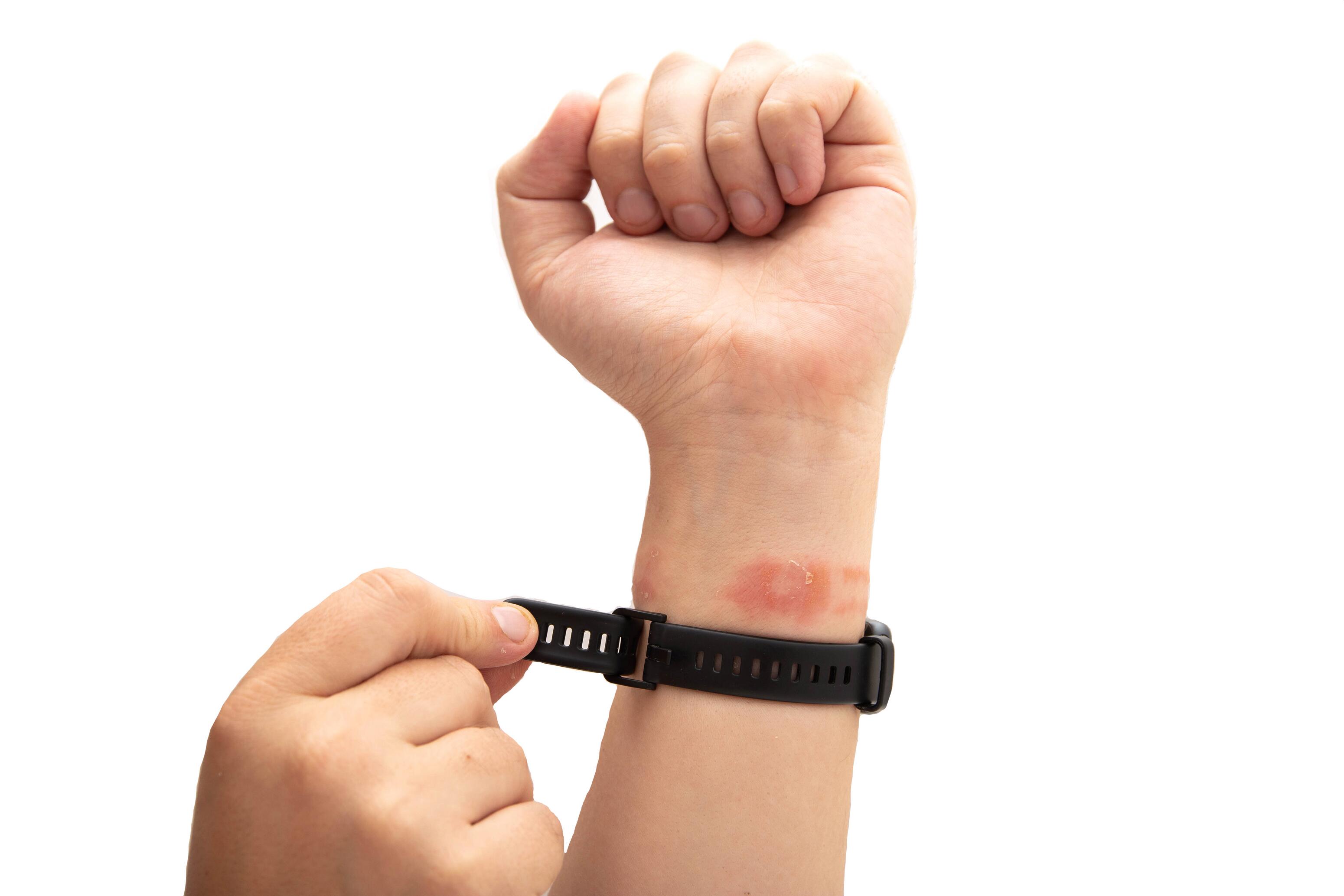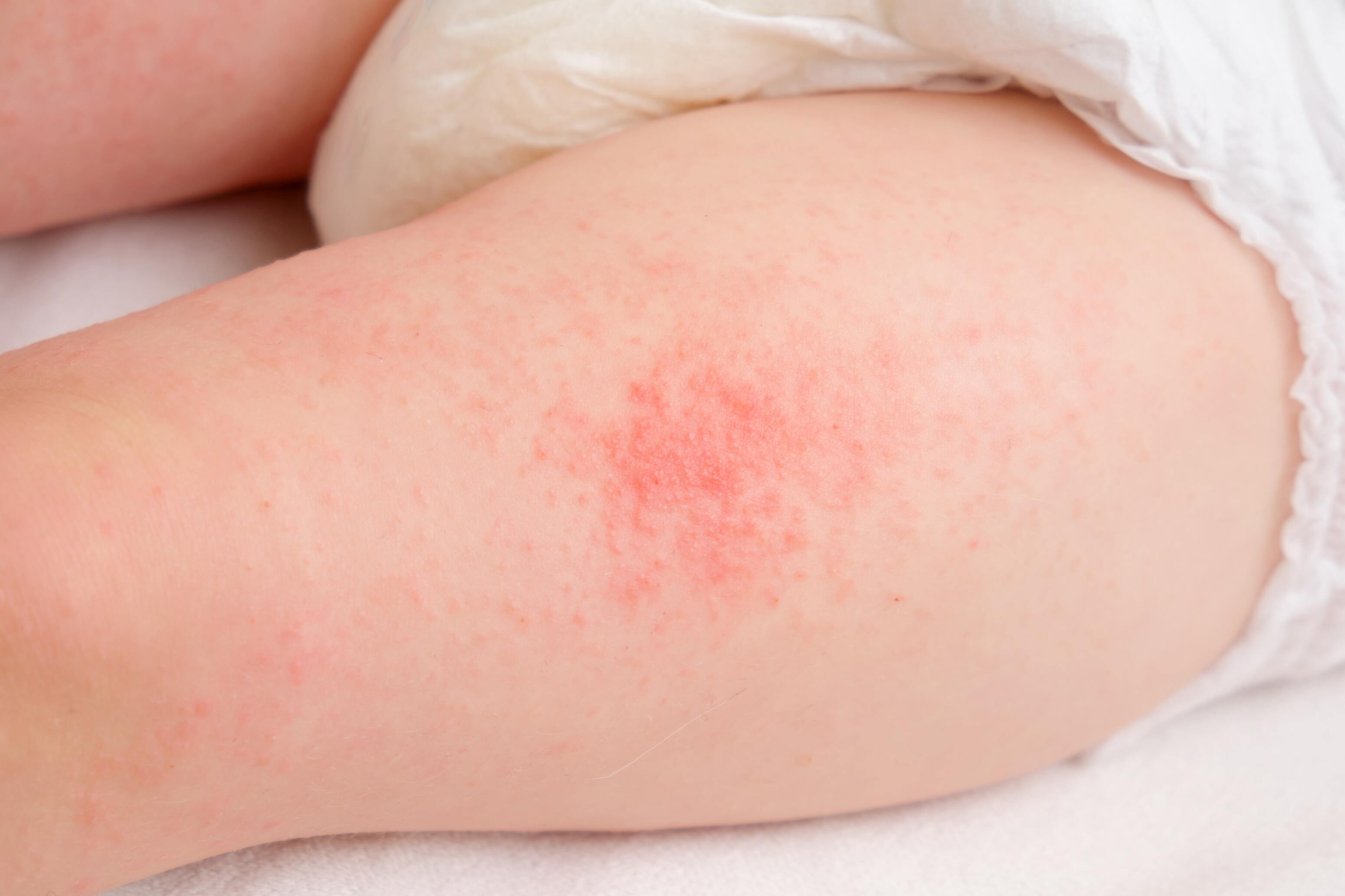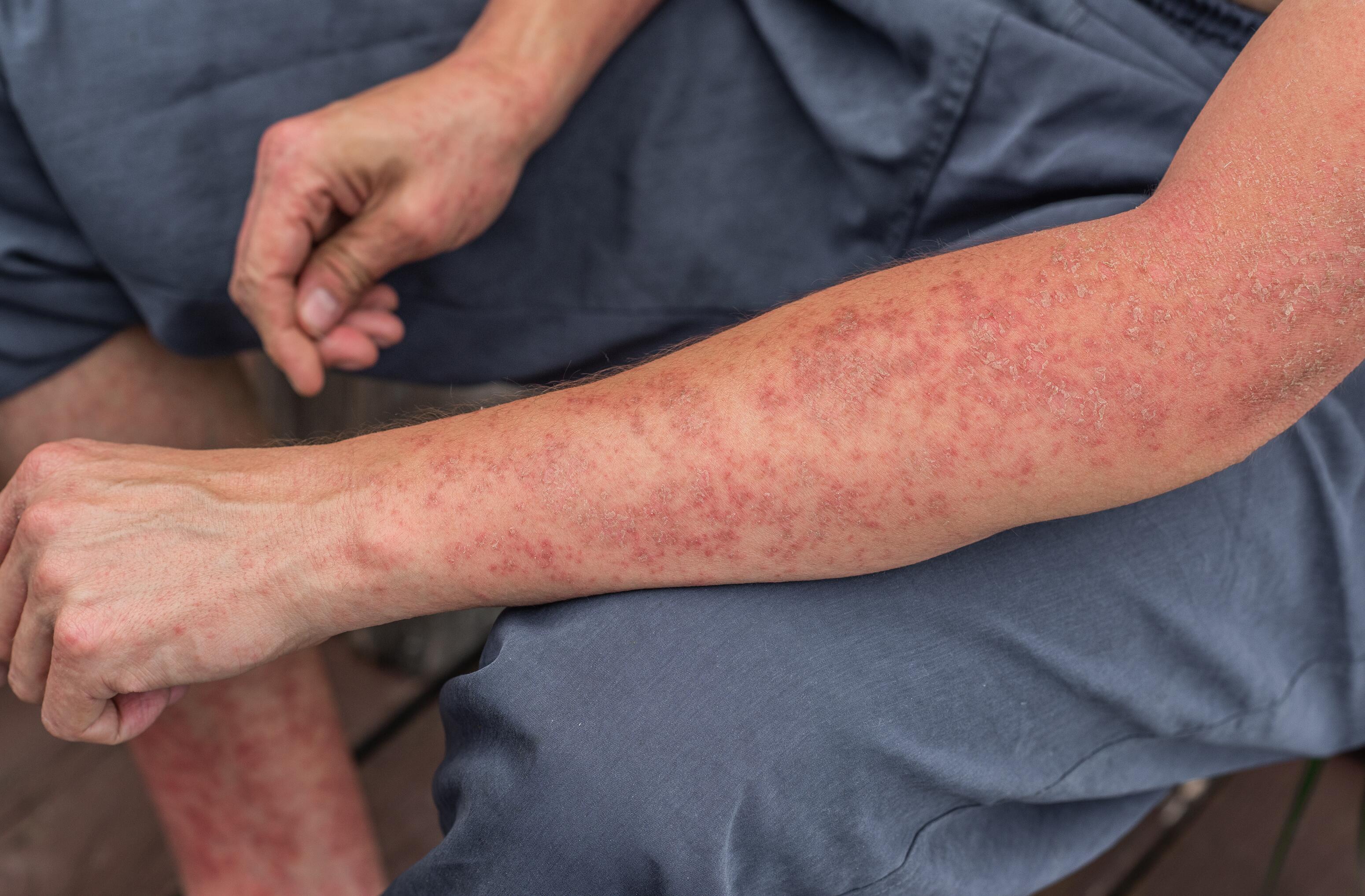"Dry Eczema": Hydrating Treatments & Practical Advice
Discover how to treat "dry eczema" with Dexeryl's hydrating solutions. Tips for soothing and repairing your dry skin.
What is "Dry Eczema"?
A Clinical Presentation of Eczema¹ ² ³
The expression "dry eczema" is used in everyday language but doesn’t refer to a distinct type or category of eczema. Much like "weeping eczema" or "lichenified eczema," "dry eczema" describes a clinical presentation of the condition. In that case, dry skin is a prominent symptom, often seen in children with atopic dermatitis.
Typically, eczema progresses with small blisters filled with clear fluid on the surface of lesions. These blisters break, leading to weeping (the weeping phase), which then dries into crusts. However, in some cases, blisters are minimal on the eczema patches, and dry skin, scales, and redness dominate the symptoms.
Thus, the terms "dry eczema" and "weeping eczema" can describe two phases of the same disease that may alternate in the same person over time.
Characteristic Symptoms of Eczema¹ ² ³
The primary symptom of eczema is dry skin, leading to intense and persistent itching. Other symptoms include redness and scales. The skin affected by eczema often feels tight and cracked, exacerbating discomfort and feelings of tightness.
Asteatotic Eczema³ ⁴
Asteatotic eczema is a specific form of the condition characterized by extremely dry, flaky skin with red cracks. It mainly affects older individuals on the front of their legs in cold and dry weather.
Symptoms of asteatotic eczema include dry skin, cracks, itching, redness, and burning sensations. Without treatment, these cracks can deepen, forming painful sores with a risk of infection.
Causes of Eczema¹ ²
The causes of eczema are multifactorial
Genetic and Hereditary Factors
Genetics plays a role in eczema. People with a history of atopic dermatitis or allergies often have a common mutation in the filaggrin gene, a protein essential for the skin's integrity.

Immune System Imbalances
An abnormal immune response (Th2 type) to common allergens causes excessive skin inflammation, leading to symptoms.

Skin Barrier Dysfunctions
Eczema is associated with skin abnormalities. Particularly in atopic dermatitis, there are dysfunctions in filaggrin, an essential protein for the formation and hydration of the skin's upper layer. A decrease in natural moisturizing factors (NMF) worsens skin dryness, and increased skin permeability makes it easier for irritants, allergens, and pathogens to penetrate.
Environmental Factors
Various environmental factors can contribute to eczema:
- Climate conditions: Exposure to dry environments due to climate or excessive use of heating and air conditioning can dehydrate the skin and exacerbate symptoms.
- Hygiene habits: Too frequent and too hot baths and showers, use of irritating cleansing products or cosmetics.
- Irritants and chemicals: Wool and synthetic textiles, perfumes, soaps, detergents, solvents, and certain cosmetics.
- Food allergens: In some atopic individuals, especially children and infants, eating foods they're allergic to (eggs, peanuts, seafood, nuts) can trigger an eczema flare-up.

Stress and Emotional Factors² ⁵
Stress can also influence the onset and severity of eczema by disrupting the immune system and skin barrier.

Solutions and Treatments for Eczemas with Significantly Dry Skin
Hydration: The Key Role of Emollient Creams¹ ⁶
Hydrating with emollients, such as DEXERYL Emollient Cream, is the cornerstone of eczema treatment. Emollients help restore the skin barrier, reduce dryness, and soothe itching. By forming a protective layer on the skin that retains moisture, these creams are essential for skin hydration.
Natural Treatments and Their Effectiveness⁷
Some natural treatments can help relieve eczema, but they may also prove ineffective or even harmful in some cases. Therefore, consulting a dermatologist for advice is crucial before incorporating these treatments into your care routine.
Thermal Cures⁷ ⁸
Thermal cures are a widely validated natural treatment for eczema. Rich in minerals and trace elements, thermal waters soothe dry skin and relieve itching and irritation. Stays in thermal centers can also include dietary advice and skincare tips, contributing to a holistic treatment of eczema.
Plant Oils⁷ ⁹
Certain plant oils, such as coconut, sunflower, sandalwood, or evening primrose oils, are known for their anti-inflammatory and antioxidant properties. They might contribute to skin hydration and inflammation reduction, but their effectiveness has yet to be established compared to emollient creams.
Gemmotherapy⁷ ¹⁰
Gemmotherapy, a form of phytotherapy that uses plant buds and young shoots, could offer benefits in treating eczema, but its effectiveness remains to be validated by rigorous scientific studies.
Aromatherapy⁷
Essential oils like lavender or rose geranium are often mentioned for their soothing properties, but essential oils pose risks of irritation, allergic reactions, or even contact eczema. Therefore, aromatherapy is contraindicated in eczema.
Practical Advice for Daily Management of Eczema¹ ⁶ ¹¹
Several daily measures are essential for eczema prevention:
- Apply an emollient, such as DEXERYL Emollient Cream, at least twice a day, ideally within minutes of showering or bathing, to maintain skin hydration.
- Take short showers or baths, 5 to 10 minutes, with lukewarm water, and use gentle, soap-free cleansers.
- Dry your skin by dabbing, not rubbing.
- Wear clothes made of natural fibers (cotton, linen). Avoid irritating materials such as wool and synthetic fabrics.
- At home, maintain comfortable humidity and cool temperatures.
- For stress prevention, engage in relaxing activities.
- Identify and eliminate potential allergens from your environment.
- Wear gloves when using cleaning products and reinforce the application of emollients during winter when the weather is cold and dry.
- Consult your dermatologist for regular follow-up.
The Importance of Choosing the Right Products for Dry Skin
Selecting Products Suited to Dry Skin¹ ⁶ ¹¹
Treating and preventing eczema requires a careful selection of skincare products to maintain skin health and minimize discomfort related to dryness and inflammation. Here are some dermatological tips for treating eczema with significant dry skin:
- Appropriate hydrating products: Choose emollients specially formulated for dry, very dry, and atopic skin without irritating or allergenic ingredients such as fragrances, parabens, alcohols, dyes, and preservatives.
- Choice of ingredients: Favor a validated product, such as a medical device or medicine, with a simple, hypoallergenic formula. Hydrating agents like glycerol, which retains moisture, are beneficial, as are vaseline and paraffin, which offer protective action and help restore the skin barrier.

- Be mindful of irritants: Cosmetic products often contain detergents and fragrances that can be irritating or allergenic. Products labeled "natural" may also have allergenic potential.
- Gentle cleaning products: Use mild and hydrating cleansers that are soap-free.

Dermatological advice: If unsure about the appropriate products for your eczema, a dermatologist can guide you toward the most suited skin care.

Reference:
1. Nemeth V, Evans J. Eczema. In: StatPearls. Treasure Island (FL): StatPearls Publishing; 2023 Jan. [Disponible sur :] https://www.ncbi.nlm.nih.gov/books/NBK538209/
2. L’Assurance Maladie. Eczéma ou dermatite atopique : causes, symptômes et évolution. Ameli.fr. 2023 Sep. [Disponible sur :] https://www.ameli.fr/assure/sante/themes/eczema-atopique/reconnaitre-eczema-atopique
3. Hering M. Eczéma sec, eczéma suintant : quelles différences ? Association Française de l’Eczéma. 2021 May. [Disponible sur :] https://www.associationeczema.fr/eczema-sec-eczema-suintant-quelles-differences/
4. Specht S, Persaud Y. Asteatotic Eczema. In: StatPearls [Internet]. Treasure Island (FL): StatPearls Publishing; 2023 Jan. [Disponible sur :] https://www.ncbi.nlm.nih.gov/books/NBK549807/
5. Arndt J, Smith N, Tausk F. Stress and atopic dermatitis. Curr Allergy Asthma Rep. 2008 Jul;8(4):312-7.
6. National Eczema Society. Emollients Factsheet. National Eczema Society. 2023 Jun. [Disponible sur :] https://eczema.org/wp-content/uploads/Emollients-Jun-23.pdf
7. Wollenberg A and al. Consensus-based European guidelines for treatment of atopic eczema (atopic dermatitis) in adults and children: part II. J Eur Acad Dermatol Venereol. 2018 Jun;32(6):850-878.
8. Cacciapuoti S and al. The Role of Thermal Water in Chronic Skin Diseases Management: A Review of the Literature. J Clin Med. 2020 Sep 22;9(9):3047.
9. Shi K, Lio PA. Alternative Treatments for Atopic Dermatitis: An Update. Am J Clin Dermatol. 2019 Apr;20(2):251-266.
10. Donno D and al. Biomolecules and Natural Medicine Preparations: Analysis of New Sources of Bioactive Compounds from Ribes and Rubus spp. Buds. Pharmaceuticals (Basel). 2016 Feb 5;9(1):7.
11. Wollenberg A and al. European guideline (EuroGuiDerm) on atopic eczema - part II: non-systemic treatments and treatment recommendations for special AE patient populations. J Eur Acad Dermatol Venereol. 2022 Nov;36(11):1904-1926.
- Discover Eczema and urticaria: Identifying and Managing Them Successfully
Eczema and urticaria: Identifying and Managing Them Successfully
- Discover Eczema Spots: How to Identify, Treat, and Prevent Them?
Eczema Spots: How to Identify, Treat, and Prevent Them?




